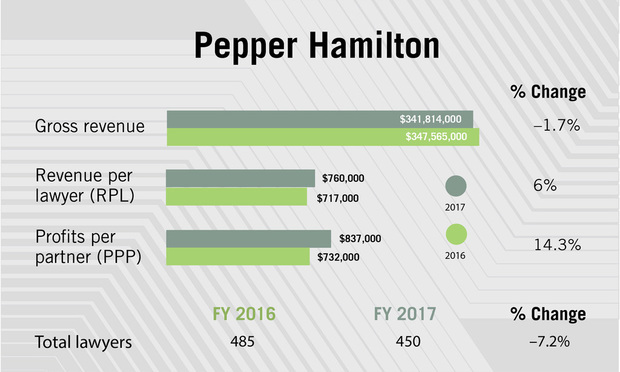Pepper Hamilton Revenue Down 1.7 Percent, PPP Up 14.3 Percent
The firm saw per-lawyer gains as head count shrank, in a year when it restructured a major practice group.
February 16, 2018 at 03:43 PM
5 minute read

After a challenging 2016, Pepper Hamilton recovered some ground in profits per partner last year amid partner departures and a slight dip in revenue.
Pepper Hamilton saw revenue decline by 1.7 percent, from $347.5 million in 2016 to $341.8 million in 2017, as total head count shrank. But profits per equity partner increased by 14.3 percent in 2017, reaching $837,000 distributed among a smaller equity partnership. Partner profits are still shy of the $1 million mark the firm hit in 2015, meanwhile.
Revenue per lawyer was $760,000, up 6 percent from 2016. And net income, at $101.3 million, was up 4.9 percent.
 The firm saw greater hours per lawyer in 2017, firm chairman Tom Gallagher said, and billing increases were below 3 percent.
The firm saw greater hours per lawyer in 2017, firm chairman Tom Gallagher said, and billing increases were below 3 percent.
“It's a tough environment out there,” managing partner Tom Cole said, with regard to billing rate increases.
Departures, Then Recruiting Changes
Pepper Hamilton saw a number of departures at the beginning of the year, with a total of 23 partners leaving throughout 2017. They included three employee benefits partners who went to Blank Rome, and four lawyers who focused on institutional response to sexual misconduct, led by partners Gina Maisto Smith and Leslie Gomez, who departed for Cozen O'Connor.
The firm also hired seven partners laterally in 2017.
In a February 2017 interview, Gallagher said the departures from preceding weeks would have no material impact on the firm. One year later, he said that prediction played out in the financial results for the year.
“Much more significant was our productivity and profitability,” Gallagher said. “We were relentlessly focused on talent management and our strategic approach to the practices.”
To that end, the firm created two new roles in 2017: chief talent officer and chief lateral partner recruitment officer. Margaret Suender, a longtime staff member and former lawyer at Pepper Hamilton, is the chief talent officer, and Karen Anderson joined from Perkins Coie to take the recruiting role. Cole said the firm created those positions to “professionalize” the recruitment process.
The firm's total head count decreased by 7.2 percent to 450 lawyers, and equity partner head count was down 8.3 percent, to 121. But Gallagher and Cole pointed to some key lateral hires.
Several of those hires were “boomerangs,” Cole noted—lawyers who previously worked at Pepper Hamilton and returned. Rachael Bushey, along with partner Jennifer Porter and an associate, rejoined Pepper Hamilton in November, after leaving the firm for Hogan Lovells a year-and-a-half earlier. Bushey's 2016 departure with two other partners was seen as a major loss for Pepper Hamilton at the time.
And in September, Lisa Kabnick and Kathryn Pourmand Nordick rejoined Pepper Hamilton from Reed Smith, adding to the firm's commercial department and financial services capabilities. Gallagher also noted financial services partner Scott Samlin and commercial litigator Peter Haveles as important 2017 partner hires.
In its health sciences department, in addition to Bushey and Porter, Pepper Hamilton hired Deborah Spranger from Saul Ewing Arnstein & Lehr, where she had led the business and finance and life sciences practices.
Spranger and Bushey both said they were attracted to Pepper Hamilton by changes in its approach to health care-related work. The firm's health effects litigation practice suffered a decline in revenue in 2016, the firm said last year. But in March, it became part of a larger, 110-lawyer, multi-practice health sciences department.
While the firm did not provide a breakdown of year-to-year performance for the health sciences department's practice groups, Cole said the department is “thriving.” The health effects litigation practice remains active, he said, continuing to represent clients like Eli Lilly and Co., GlaxoSmithKline, Medtronic and the National Football League.
Other practices that did well, Cole and Gallagher said, were transactional, commercial litigation, intellectual property and white-collar, both in health sciences and in other fields. Asked whether any practices were weak, they said none were inconsistent with budgeted expectations.
Looking Ahead
For 2018, Pepper Hamilton will continue to focus on talent acquisition, Gallagher said, noting that the firm is in the process of making additional lateral hires. Asked about the potential for mergers, he said there is nothing currently on the table, but the firm is open to good combination opportunities.
The firm still isn't planning any major rate increases, Cole said, but alternative fee arrangements have become more prominent. He said the firm has become “proactive” about offering those options to clients.
“When a case is filed we say … here is our strategy, and that includes a budget,” he said. That budget includes tailored staffing details, Cole said, and is developed using pricing specialists.
Asked whether the firm expects to return to its size and gross revenue levels from before 2016, Gallagher said Pepper Hamilton is focused on 2018, rather than the past.
“The most important thing is delivering profitable work. We're very pleased with revenue per lawyer, profits per lawyer,” he said.
Whether 2017 productivity levels are sustainable, given industrywide demand flatness, he said yes—with the right recruiting strategy.
“The focus on talent management is an important factor,” he said. “We expect that to continue.”
This content has been archived. It is available through our partners, LexisNexis® and Bloomberg Law.
To view this content, please continue to their sites.
Not a Lexis Subscriber?
Subscribe Now
Not a Bloomberg Law Subscriber?
Subscribe Now
NOT FOR REPRINT
© 2025 ALM Global, LLC, All Rights Reserved. Request academic re-use from www.copyright.com. All other uses, submit a request to [email protected]. For more information visit Asset & Logo Licensing.
You Might Like
View All


'The World Didn't End This Morning': Phila. Firm Leaders Respond to Election Results
4 minute read
Settlement With Kleinbard in Diversity Contracting Tiff Allows Pa. Lawyer to Avoid Sanctions
3 minute readTrending Stories
- 1Uber Files RICO Suit Against Plaintiff-Side Firms Alleging Fraudulent Injury Claims
- 2The Law Firm Disrupted: Scrutinizing the Elephant More Than the Mouse
- 3Inherent Diminished Value Damages Unavailable to 3rd-Party Claimants, Court Says
- 4Pa. Defense Firm Sued by Client Over Ex-Eagles Player's $43.5M Med Mal Win
- 5Losses Mount at Morris Manning, but Departing Ex-Chair Stays Bullish About His Old Firm's Future
Who Got The Work
J. Brugh Lower of Gibbons has entered an appearance for industrial equipment supplier Devco Corporation in a pending trademark infringement lawsuit. The suit, accusing the defendant of selling knock-off Graco products, was filed Dec. 18 in New Jersey District Court by Rivkin Radler on behalf of Graco Inc. and Graco Minnesota. The case, assigned to U.S. District Judge Zahid N. Quraishi, is 3:24-cv-11294, Graco Inc. et al v. Devco Corporation.
Who Got The Work
Rebecca Maller-Stein and Kent A. Yalowitz of Arnold & Porter Kaye Scholer have entered their appearances for Hanaco Venture Capital and its executives, Lior Prosor and David Frankel, in a pending securities lawsuit. The action, filed on Dec. 24 in New York Southern District Court by Zell, Aron & Co. on behalf of Goldeneye Advisors, accuses the defendants of negligently and fraudulently managing the plaintiff's $1 million investment. The case, assigned to U.S. District Judge Vernon S. Broderick, is 1:24-cv-09918, Goldeneye Advisors, LLC v. Hanaco Venture Capital, Ltd. et al.
Who Got The Work
Attorneys from A&O Shearman has stepped in as defense counsel for Toronto-Dominion Bank and other defendants in a pending securities class action. The suit, filed Dec. 11 in New York Southern District Court by Bleichmar Fonti & Auld, accuses the defendants of concealing the bank's 'pervasive' deficiencies in regards to its compliance with the Bank Secrecy Act and the quality of its anti-money laundering controls. The case, assigned to U.S. District Judge Arun Subramanian, is 1:24-cv-09445, Gonzalez v. The Toronto-Dominion Bank et al.
Who Got The Work
Crown Castle International, a Pennsylvania company providing shared communications infrastructure, has turned to Luke D. Wolf of Gordon Rees Scully Mansukhani to fend off a pending breach-of-contract lawsuit. The court action, filed Nov. 25 in Michigan Eastern District Court by Hooper Hathaway PC on behalf of The Town Residences LLC, accuses Crown Castle of failing to transfer approximately $30,000 in utility payments from T-Mobile in breach of a roof-top lease and assignment agreement. The case, assigned to U.S. District Judge Susan K. Declercq, is 2:24-cv-13131, The Town Residences LLC v. T-Mobile US, Inc. et al.
Who Got The Work
Wilfred P. Coronato and Daniel M. Schwartz of McCarter & English have stepped in as defense counsel to Electrolux Home Products Inc. in a pending product liability lawsuit. The court action, filed Nov. 26 in New York Eastern District Court by Poulos Lopiccolo PC and Nagel Rice LLP on behalf of David Stern, alleges that the defendant's refrigerators’ drawers and shelving repeatedly break and fall apart within months after purchase. The case, assigned to U.S. District Judge Joan M. Azrack, is 2:24-cv-08204, Stern v. Electrolux Home Products, Inc.
Featured Firms
Law Offices of Gary Martin Hays & Associates, P.C.
(470) 294-1674
Law Offices of Mark E. Salomone
(857) 444-6468
Smith & Hassler
(713) 739-1250





